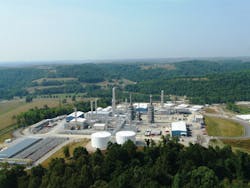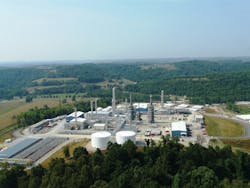Opportunities and pitfalls of y-grade
With the correct approach to risk management, y-grade can be successfully fractionated into saleable NGLs.
Peter Cooperman
Triple Point Technology
Westport, Conn.
Y-grade (raw mix) provides an excellent opportunity for companies to profit by fractionating and selling its purity products, but the path to success is an arduous one. Whatever challenges midstream players face in the NGLs market, they can use existing technology solutions to mitigate risk and manage the complete life cycle of y-grade, from gathering to purity product selling.
Improvements in drilling and hydraulic fracturing techniques across the United States have reshaped the landscape of energy markets. Abundant supplies of natural gas and crude oil have been recovered from shale rock and tight sands along with large amounts of associated byproducts. In most industries, this would have a negative connotation. However, this isn't the case for natural gas and crude oil. In fact, well operators have relocated their rigs to intentionally drill for wet gas and hydrocarbon heavy crude to produce higher volumes of a valuable byproduct known as raw mix or y-grade.
Producers have attracted more midstream participants that hope to capitalize on a growing supply of y-grade. As an aggregate of several purity products, a barrel of y-grade is valued by what its components are worth. In its natural state, y-grade has no dedicated market or known use. It must undergo processing before its true value is proven. Fractionation yields varying amounts of five natural gas liquids (NGLs): ethane (C2), propane (C3), iso-butane (I-C4), butane (N-C4), and natural gasoline (C5+), and each have their own uses and dedicated markets.
Succeeding in midstream markets means properly managing the complete lifecycle from the time y-grade is purchased to the time when each purity product is sold. Bringing NGLs to market requires physical and financial contract management, while navigating an extremely complex supply chain. It is also necessary to monitor five highly volatile markets to accurately determine the value of an initial purchase and forecasted selling prices. Risks are everywhere when dealing with NGLs. Technology provides the best means of succeeding in turning y-grade into purity profit by providing the tools needed to overcome the challenges that exist in these markets.
Growth opportunity
The current infrastructure for gathering, processing, and transporting y-grade in the US is limiting the majority of y-grade gathering and NGLs production to the middle of the country. Shale formations in Eagle Ford, the Texas side of the Granite Wash, and crude plays in the Anadarko and the Permian Basins are positioned in regions with access to pipelines that can transport y-grade to fractionation plants along the Texas Gulf Coast, and in nearby Louisiana. Once fractionation occurs, individual NGLs can be distributed by way of vessel or pipelines. But even producers in these sought-after areas are not without risks, such as plant shutdowns (even when planned) and pipeline maintenance schedules that may delay processing and delivery of purity products.
Meanwhile, other regions in the country are limited by a lack of fractionation facilities and pipelines capable of handling y-grade or NGLs. Some turn to methods designed for transporting liquefied natural gas. However, most natural gas and crude oil producers are simply injecting y-grade back into drill sites until they have an economical means of transporting or fractionating it. Relief is coming, according to recent industry news. Numerous companies have made commitments to developing infrastructure throughout the country. In the Marcellus region, Sunoco Inc. is one of several companies that have announced projects aimed at repurposing pipelines and bringing dormant facilities back online to fractionate NGLs and take advantage of the y-grade opportunity.
Petrochemical companies and refineries are also investing in expansion projects and in building new facilities to take advantage of the growing supply of NGLs. These industries use NGLs as feedstock and are expected to have a positive impact on demand as their facilities come online. Increasing demand, along with improved transportation and infrastructure for processing create greater opportunity for midstream participants.
Logistics
Managing supply chain begins with accurately plotting the projected physical movement of y-grade from gathering points to fractionation facilities and estimating the costs associated with doing so. As infrastructure changes and more participants join the market, optimizing available pipelines and fractionation facilities will become increasingly difficult. Creating a visual representation of potential transport routes is valuable because it promotes quick decision-making and helps participants avoid obstacles that may create supply interruptions. Once y-grade goes through fractionation, the challenge increases fivefold. Ethane and pentane, for example, have entirely different transportation requirements.
Supply chain management plays a large role in a participant's ability to succeed in NGLs because every y-grade acquisition must relate back to a contract of sale and a delivery schedule for each individual purity product. Keeping track of the location, processing phase, volume, and purity of each NGL, along every stage of the supply chain, allows for advanced planning. It also creates opportunities to blend different supply stocks to ensure that end product quality is optimized to meet contractual commitments, reduce settlement fees, and increase profits.
Purchase pricing
Once midstream participants determine an optimal supply chain process, they then need to determine a fair purchase price for y-grade. Valuation requires monitoring a minimum of five NGLs markets, and with each comes volatility. Different end-uses drive demand, which can severely affect the sale price of each purity product. Participants must keep a watchful eye on price index data from OPIS to follow individual price movements. NGLs are priced by $/gallon and y-grade is sold by the barrel, so calculations must be made at each turn to convert prices into like units. Relying on spreadsheets, manual lookups, and calculations puts midstream players at risk of making transcription errors, which could have devastating effects on a transaction and quickly turn a perceived profitable transaction into a loss.
Managing physical and financial contracts
Contracts are a vital part of managing risk associated with commodity trading. When dealing with NGLs midstream transactions, the concentrations, quality, and volume of each NGL must be considered. Sample testing occurs throughout the processing, transport and fractionation of every batch of y-grade until end products are delivered. These readings amount to a constant stream of information that must be properly tracked and recorded. When there are discrepancies between agreed upon values and actual samples, settlements must be made. The data that must be gathered for a single purchase of y-grade can be overwhelming to manage manually. Participants expecting to rely on spreadsheets and manual calculations to succeed in midstream markets are likely to fail and should instead consider using software to greatly improve the likelihood of profiting in the challenging midstream markets.
Manage risk, optimize supply chain with ETRM
The financial and physical risks that exist in the NGLs midstream market require the use of advanced technology to manage the complexities of purchasing y-grade and navigating the process of converting and marketing it as purity products. As traders recognize the importance of quickly interpreting complex data from multiple sources-to promote smart trading decisions-they must address several key challenges.
The following areas must be addressed to maximize profits from y-grade to NGLs trading:
- Minimize supply chain risk with advanced physical contract handling; manage quantities traded and scheduled at an aggregate level, with pricing, cash flow position, and mark to market (MTM)/ fair value accounting based on individual components.
- Optimize purchase allocation of y-grade purchases to meet sale obligations.
- Mitigate enterprise risk through optimizing fractionation (based on long positions) to determine ideal inventory of individual components by integrating physical and financial instruments, optimizing cross-commodity and FX hedging strategies, and rapidly identifying arbitrage opportunities across markets and products.
- Track inventory handling and movements with clearly labeled visual displays of all activity, industry recognized visual cues, and advanced reporting capabilities.
- Model ideal blending scenarios to maximize profit by determining the best blending scenario across all contracts. This can be done through an analysis of each purity product supply stock mapped back to contract delivery and minimum purity requirements.
- Handle comprehensive and reliable unit of measure (UOM) and cross-conversions that support quantities traded and scheduled in Volumetric UOMs, potentially converted to Mass UOMs, but more importantly, supporting energy-equivalent positions for hedging, consolidated gas portfolio reporting, and frac spread calculations.
An ideal approach to these challenges involves using an enterprise risk management system (ETRM). A system that integrates with price indexes, manages both physical and financial contracts, and optimizes the complete supply chain from y-grade straight through to sale of NGLs, can provide midstream market participants with the tools they need for success.
Advancing with technology
The growing NGLs market offers a opportunity to profit from byproducts. The NGLs midstream market mandates that participants hone their expertise in several subjects related to physical and financial contract handling, supply chain management, and trade optimization. Technology is crucial to profiting in the y-grade to NGLs marketplace. ETRM software enables users to accurately monitor and calculate risk while informing smarter trading and supply chain decisions.
About the Author
Peter Cooperman is a marketing specialist at Triple Point Technology, a provider of on-premise and in-cloud commodity management. He holds a bachelor's degree in economics from Binghamton University.


